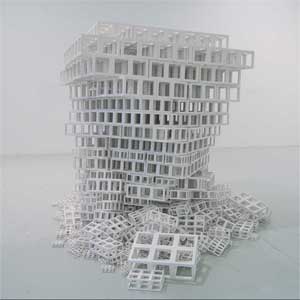

When I first met John Powers five+ years ago, he was like a Tibetan monk with a pile of sand. Only instead of sand, he had thousands of 1-inch woodblocks, which he transformed into a huge, impossibly intricate, mandala-like sculpture that sprawled across the floor of Exit Art’s gallery. Every day throughout the exhibit, he scooted around on a little skateboard chair, replicating and altering dense patterns of blocks as he went. The work wasn’t “finished” when the show ended, and he swept the whole thing away, but that, I think was part of the point.
Now, in his latest show at Virgil de Voldere Gallery in the Chelsea Arts Building, Powers is reconfiguring hundreds? thousands? of white, Sol Lewitt-like grid modules into a new sculpture every day. The gallery’s website has pictures of the ones you’ve missed, but you can also stop by until Oct. 9th to watch new pieces come together.
John Powers at Virgil de Voldere through Sun., Oct. 9 [virgilgallery.com]
Author: greg
John Powers-a-Day at Virgil de Voldere Gallery


When I first met John Powers five+ years ago, he was like a Tibetan monk with a pile of sand. Only instead of sand, he had thousands of 1-inch woodblocks, which he transformed into a huge, impossibly intricate, mandala-like sculpture that sprawled across the floor of Exit Art’s gallery. Every day throughout the exhibit, he scooted around on a little skateboard chair, replicating and altering dense patterns of blocks as he went. The work wasn’t “finished” when the show ended, and he swept the whole thing away, but that, I think was part of the point.
Now, in his latest show at Virgil de Voldere Gallery in the Chelsea Arts Building, Powers is reconfiguring hundreds? thousands? of white, Sol Lewitt-like grid modules into a new sculpture every day. The gallery’s website has pictures of the ones you’ve missed, but you can also stop by until Oct. 9th to watch new pieces come together.
John Powers at Virgil de Voldere through Sun., Oct. 9 [virgilgallery.com]
George Bush Defends Kate Moss
Rang dang diggity dang-de-dang…
Just when you think this remix of George W. Bush covering “White Lines” couldn’t get any better, comes this line about two minutes in:
Some a**hole took a picture
of Kate Moss doing lines,
And now she’s being victimized
for imaginary crimes
White Lines, sung by a guy who knows [thepartyparty via waxy]
George Bush Defends Kate Moss
Rang dang diggity dang-de-dang…
Just when you think this remix of George W. Bush covering “White Lines” couldn’t get any better, comes this line about two minutes in:
Some a**hole took a picture
of Kate Moss doing lines,
And now she’s being victimized
for imaginary crimes
White Lines, sung by a guy who knows [thepartyparty via waxy]
I Stand Corrected. The Movie Trailer IS An Art Form
Absolutely brilliant.
“Meet Jack Torrance. He’s a writer looking for inspiration.
Meet Danny. He’s a kid, looking for a dad.”
Shining: the remixed trailer [via waxy, who’s mirroring it.]
I Stand Corrected. The Movie Trailer IS An Art Form
Absolutely brilliant.
“Meet Jack Torrance. He’s a writer looking for inspiration.
Meet Danny. He’s a kid, looking for a dad.”
Shining: the remixed trailer [via waxy, who’s mirroring it.]
Cinema Paramilitaristo

Despite the ravages of war and the censorship imposed by local religious authorities, a lovable young scamp in a rubble-strewn town finds solace, even hope, in the movies.
If only there was a kindly old projectionist to take the place of the boy’s father, who’d been disappeared at Abu Ghraib…
Defying Terror, Filmgoers Attend a Festival in Baghdad [nyt]
While half of me says, “Congratulations, Karen Hughes,” the other half wonders what the story is in the two movie theaters still operating in Baghdad.
Cinema Paramilitaristo

Despite the ravages of war and the censorship imposed by local religious authorities, a lovable young scamp in a rubble-strewn town finds solace, even hope, in the movies.
If only there was a kindly old projectionist to take the place of the boy’s father, who’d been disappeared at Abu Ghraib…
Defying Terror, Filmgoers Attend a Festival in Baghdad [nyt]
While half of me says, “Congratulations, Karen Hughes,” the other half wonders what the story is in the two movie theaters still operating in Baghdad.
Guggenheim? Good Luck With That
Tyler goes all Observer on Thomas Krens’ butt, while giving new Guggenheim director Lisa Dennison a chance to share her vision for the credibility-starved museum: “I would like the person on the street at Pastis to be able to name our top five curators.”
Personally, after seeing Dennison threaten to deaccession the work of an artist who criticised the the way she installed it, [“Well, if he doesn’t want to be in the museum’s collection, then…”] I’m sure we’ll be brunching over the Guggenheim for years to come.
Krens Relinquishes The Ramps!
Ms. Dennison To Feed Starved Gugg [observer.com]
Guggenheim? Good Luck With That
Tyler goes all Observer on Thomas Krens’ butt, while giving new Guggenheim director Lisa Dennison a chance to share her vision for the credibility-starved museum: “I would like the person on the street at Pastis to be able to name our top five curators.”
Personally, after seeing Dennison threaten to deaccession the work of an artist who criticised the the way she installed it, [“Well, if he doesn’t want to be in the museum’s collection, then…”] I’m sure we’ll be brunching over the Guggenheim for years to come.
Krens Relinquishes The Ramps!
Ms. Dennison To Feed Starved Gugg [observer.com]
Penguin Filmmakers Behaving Badly
Dateline, Paris [of course]:
In Hollywood, meanwhile, the jockeying for credit on March of the Penguins was taking place. Last month, Jordan Roberts, a film director turned writer, claimed credit in a Los Angeles Times article for essentially “re-envisioning” the film by writing the narration and substituting a new soundtrack.
Mr. Jacquet scoffs at that view. “There are millions of people around the planet who like the French version, my version,” he said with a laugh. And like the penguin stars of the movie, Mr. Jacquet has never met Mr. Roberts.
Of course, the ones that saw Roberts’ reworking of your treacly Look Who’s Talking! version have been stuffing $71 million down your gullet, Mr. Jacquet.
Compared With Their Filmmakers, the Penguins Have It Easy [nyt]
Mike Mills: The Kultureflash Interview
AB: Were you always going to adapt it [Thumbsucker]?
MM: No, not at the beginning because I hadn’t done it before but quite quickly on I thought, “Wait a second I can’t imagine directing something I didn’t write. Let me at least try.” I made a deal with Bob: “Let me try the first thirty pages.” And in that first time of adapting it, it really became clear how much cathartic mileage I was getting out of this and how I related to Justin and how much having him as a character was allowing me to say things that I wanted to say, that I needed to say. It’s like you know when you make a part of yourself that’s kinda weak into one of the characters, it emboldens you. You can be strong with it or you can fall down with it and still survive. The facts are very different and most of the details are very different but the emotional underpinnings are very similar between him and his mother and me and my mother. Then the estrangement he had with his dad is totally different, my dad is completely different but the estrangement is very familiar to me. So it became very personal, very quick.
Artworker of the week #51: Mike Mills [kultureflash.net]
Paul Ford, Rock Star
Paul smashes his guitar of truth into the speaker tower of fiction, finally revealing to the world that he is Gary Benchley, Rock Star with a book deal–and a reading next Thursday in [where else?] Williamsburg:
As the serial progressed I stopped laughing at the people who wrote in to Gary to share a few details from their lives and began to feel a kinship with them. Like them, I had come to believe in Gary Benchley, in his struggle to get a band together and make a life for himself in New York City. I began to see the people who wrote to him as co-conspirators in the prank rather than its victims.
I Am Gary Benchley [themorningnews.org]
Hallowed-er Than Thou
 Partly because an International Freedom Center founded by George Bush’s old friend and business partner wasn’t a reassuringly hagiographic enough puppet, but mostly because it was personally expedient for them to do so, George Pataki and a dogpile of other sanctimonious politicians suddenly decided to defend the “hallowed ground” of the WTC site’s “memorial quadrant” by banning the IFC altogether.
Partly because an International Freedom Center founded by George Bush’s old friend and business partner wasn’t a reassuringly hagiographic enough puppet, but mostly because it was personally expedient for them to do so, George Pataki and a dogpile of other sanctimonious politicians suddenly decided to defend the “hallowed ground” of the WTC site’s “memorial quadrant” by banning the IFC altogether.
“Memorial quadrant”?? If only the limits of this farce were as clearly delineated. How is that quadrant any more “hallowed” than the other eight-plus acres of the site? It seems like only yesterday that the “footprints” were the sacred squares that had to be defended at all costs.
How and by whom was this quadrant defined? By the MTA, who cordoned it off in an effort to keep its sacred revenue stream as more than just a memory. And to whom are the MTA and its proxy, the LMDC, beholden? To the governor who just undid their three year’s work on the IFC and the master plan “in a stroke.”
Are we done, then? Is this enough hallow now? The last three years’ of machinations around the WTC site have reduced hallowedness to a negotiable, political commodity, apparently measured in square feet. Everyone involved in this process, from Pataki to Burlingame to Clinton to the slew of unions, has dishonored and demeaned the memories of the people attacked–and the people killed–on September 11th.
Pataki Bars Museum From World Trade Center Memorial Site [nyt]
[update: now that THAT’s out of the way, the Port Authority has announced it will develop the first 500,000 square feet of retail on the completely unhallowed sections of the WTC site. This section, called the “Mall Quadrant,” is across the to-be-extended (and equally unhallowed) Greenwich St. from the “Memorial Quadrant.”]
Officials Reveal Retail Plan for World Trade Center Site [nyt]
Tropolism: I Read It For The Articles
Although the pictures are nice, too.
Turn-ons: urbanism, Meier’s third condo tower, Gluckman Mayner’s One Kenmare, long walks on sensitively adapted elevated railroad track parks, Gordon Matta-Clark exhibitions.
Turn-offs: Freedom Center squabbles, deceptively meaningless master plans, Gwathmey’s Sculpture for Living.
